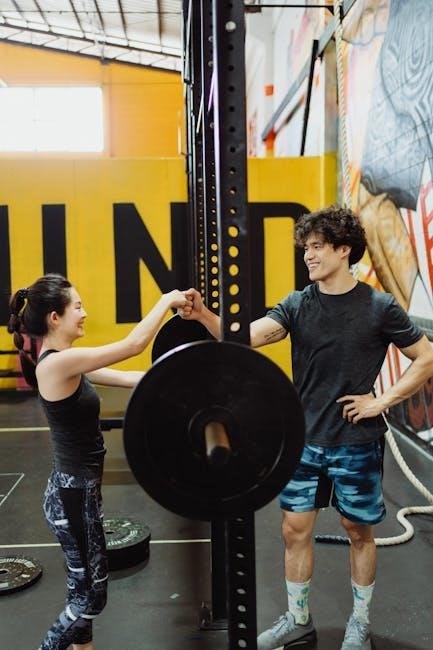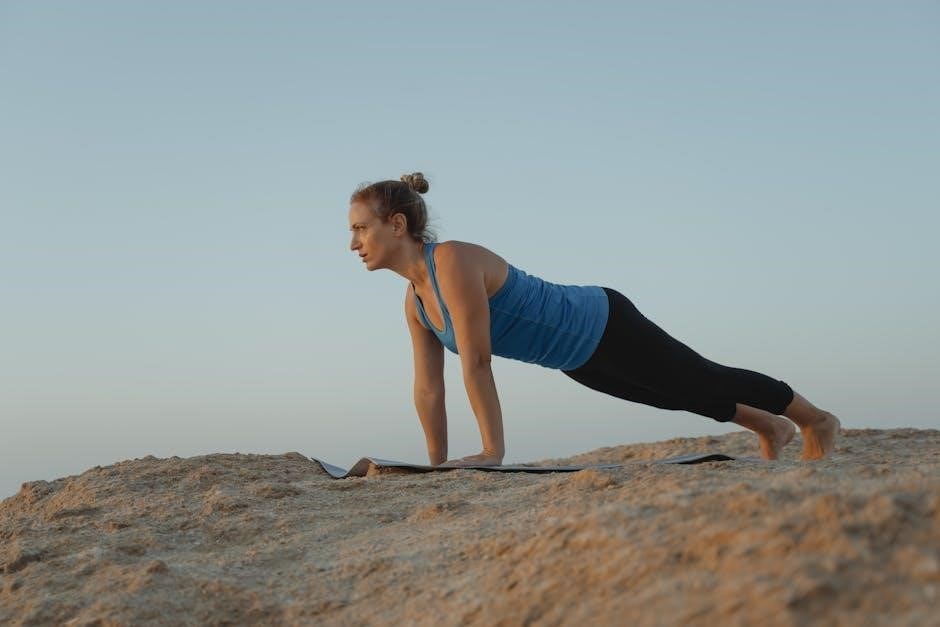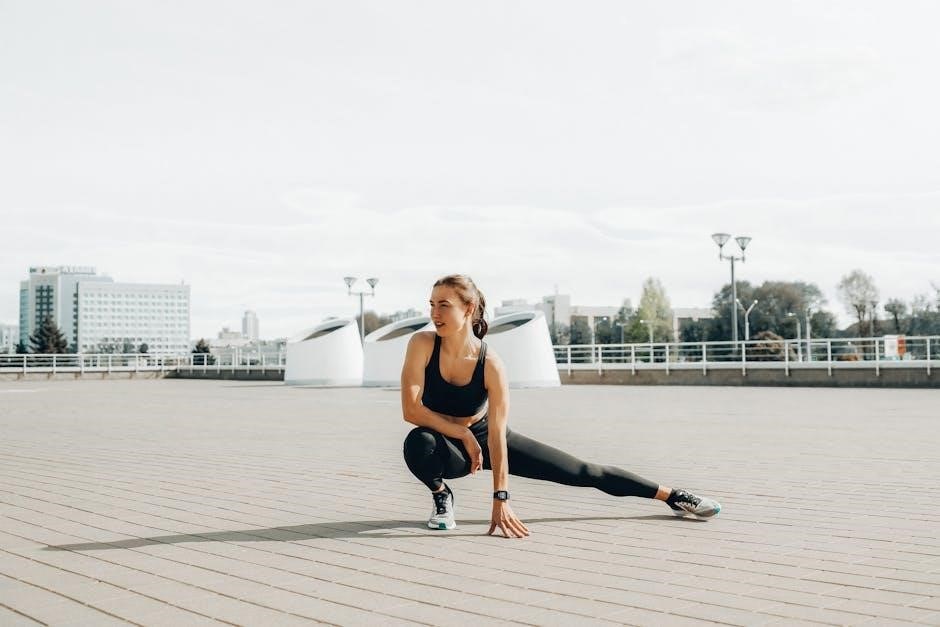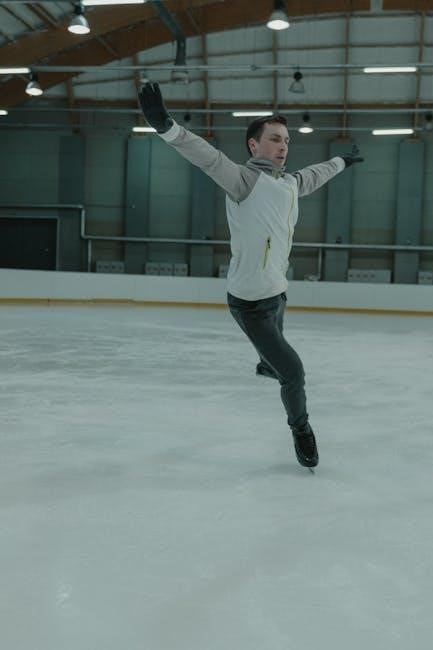A comprehensive guide offering a structured approach to shoulder rehabilitation, these downloadable and printable exercises provide step-by-step instructions for a personalized strengthening program, ensuring effective recovery and ease of use at home.
1.1 Overview of Rotator Cuff Rehabilitation
Rotator cuff rehabilitation focuses on restoring strength, mobility, and stability to the shoulder joint through targeted exercises and physical therapy. This process is essential for addressing injuries such as strains, tendinopathy, or partial tears. A well-structured program often begins with foundational exercises to improve joint stability and gradually progresses to more dynamic movements. Physical therapists play a key role in designing personalized plans tailored to the severity of the injury and the patient’s goals. Printable exercise guides are invaluable tools, providing clear instructions and visual cues to ensure proper form and consistency during home workouts. These resources empower patients to take an active role in their recovery, promoting long-term shoulder health and reducing the risk of reinjury.
Consistency and patience are critical, as recovery typically involves a gradual progression of exercises. Regular monitoring by a healthcare professional ensures the program remains effective and safe, adjusting as needed to accommodate progress or address challenges. By combining structured routines with patient engagement, rotator cuff rehabilitation can effectively restore function and alleviate pain, enabling individuals to return to their daily activities and sports with confidence.
1.2 Importance of Structured Exercise Programs
Structured exercise programs are vital for effective rotator cuff rehabilitation, ensuring a safe and progressive approach to recovery. These programs are tailored to address specific injuries, such as tendinopathy or tears, and are designed to enhance strength, mobility, and stability. By following a well-organized routine, patients can avoid overexertion and prevent further injury. Printable guides play a crucial role in maintaining consistency, as they provide clear instructions and visual cues for proper form. This structured approach also allows for gradual progression, introducing more challenging exercises as strength and mobility improve. Regular monitoring by a physical therapist ensures the program adapts to the patient’s needs, promoting optimal recovery and reducing the risk of setbacks. A structured plan not only accelerates healing but also empowers patients to take control of their rehabilitation journey, fostering independence and confidence in their progress.
1.3 Benefits of Printable Exercise Guides
Printable exercise guides offer numerous benefits for rotator cuff rehabilitation, providing clear, step-by-step instructions and visuals to ensure proper form and technique. These guides enable patients to perform exercises confidently at home, promoting consistency and adherence to their rehabilitation plan. They are highly portable, allowing individuals to access their routines anywhere, and are cost-effective, eliminating the need for expensive equipment. Printable guides also serve as a valuable resource for tracking progress, with space for notes and exercise logs. By following these structured plans, patients can maintain motivation and independence, knowing they are progressing safely toward recovery. This accessibility and clarity make printable guides an essential tool for effective rotator cuff rehabilitation.

Understanding the Rotator Cuff
The rotator cuff is a group of muscles and tendons stabilizing the shoulder joint, essential for mobility and preventing dislocation. Injuries often result from repetitive strain or trauma, causing pain and limited motion. Strengthening exercises are crucial for recovery and preventing future injuries.
2.1 Anatomy of the Rotator Cuff
The rotator cuff consists of four muscles (supraspinatus, infraspinatus, teres minor, and subscapularis) and their tendons, forming a stabilizing cuff around the shoulder joint. These muscles work together to provide stability, enable smooth movement, and prevent dislocation. The supraspinatus assists in abduction, while the infraspinatus and teres minor facilitate external rotation. The subscapularis handles internal rotation. The tendons connect these muscles to the humerus, ensuring proper alignment and function. This complex structure is essential for activities like lifting, reaching, and throwing, making it critical for both athletic and daily movements. Injuries to the rotator cuff, such as strains or tears, can severely limit mobility and cause pain. Understanding its anatomy is key to effective rehabilitation and strengthening exercises, often guided by printable exercise guides.
2.2 Functions of the Rotator Cuff
The rotator cuff plays a vital role in shoulder function, providing stability, enabling smooth movement, and preventing dislocation. It facilitates activities like lifting, reaching, and throwing by coordinating muscle actions. The supraspinatus aids in abduction, while the infraspinatus and teres minor manage external rotation, and the subscapularis handles internal rotation. This complex system ensures proper alignment and movement of the humerus within the shoulder joint. Its functions are essential for both daily tasks and athletic activities, making it a critical component of upper limb mobility. Understanding these functions is crucial for designing effective rehabilitation programs, often supported by printable exercise guides that target specific muscle groups to restore strength and functionality.
2.3 Common Rotator Cuff Injuries
Common rotator cuff injuries include tendinopathy, bursitis, and partial or full-thickness tears. These injuries often result from repetitive strain, falls, or sports-related trauma. Symptoms frequently involve shoulder pain, particularly during overhead activities or rotations, and weakness when lifting or moving the arm. Limited range of motion and difficulty performing daily tasks, such as reaching or dressing, are common complaints. Pain may worsen at night or with specific movements, like throwing or pulling. Early detection and treatment are crucial to prevent progression and improve outcomes. Physical therapy plays a key role in addressing these issues, with printable exercise guides offering structured routines to alleviate symptoms and restore function.

Types of Rotator Cuff Exercises
Exercises range from foundational strength-building movements like arm circles and shoulder blade squeezes to intermediate resistance-based activities and advanced dynamic rotations, promoting progressive strength, mobility, and functional recovery.
3.1 Foundational Exercises for Rotator Cuff Strength
Foundational exercises are essential for building initial strength and stability in the rotator cuff. These include arm circles, shoulder blade squeezes, and internal/external rotations, which target key muscles. Using tools like resistance bands or light weights, these exercises restore basic strength and improve joint stability. They are low-intensity and repetitive, making them ideal for early rehabilitation. Proper form and consistency are crucial to avoid further injury. Printable guides often include clear instructions and visuals to ensure patients perform these exercises correctly at home. By mastering these foundational movements, individuals can establish a strong base for progressive strengthening and improved shoulder function, reducing the risk of reinjury and promoting long-term recovery.

3.2 Intermediate Exercises for Progressive Strengthening
Intermediate exercises focus on gradually increasing resistance and complexity to enhance rotator cuff strength and mobility. Examples include shoulder rotations using resistance bands, side-lying shoulder exercises, and wall slides. These exercises target the supraspinatus, infraspinatus, and teres minor muscles, improving both strength and function. Resistance bands or light weights are often incorporated to challenge the muscles further. Proper form is essential to avoid strain, and printable guides typically provide step-by-step instructions and visuals to ensure safe execution. As strength improves, exercises can be modified by increasing resistance or repetitions, promoting continued progress toward full shoulder function. These intermediate steps bridge the gap between foundational stability and advanced dynamic movements, ensuring a well-rounded rehabilitation process.
3.3 Advanced Exercises for Dynamic Mobility
Advanced exercises focus on dynamic movements and functional activities to restore full shoulder mobility and strength. Examples include dynamic rotations using resistance bands, overhead presses with light weights, and plyometric exercises to enhance power. These exercises aim to reintegrate the rotator cuff into daily and sports-specific movements. Printable guides often include detailed diagrams and progression charts to ensure safe advancement. Emphasis is placed on proper form to prevent re-injury. As patients progress, exercises may incorporate multi-planar movements and reactive training to mimic real-life scenarios, promoting a seamless transition back to normal activities or athletic pursuits. These advanced steps help achieve optimal shoulder function and prepare for high-level tasks.

Tools and Equipment for Rotator Cuff Exercises
Resistance bands and water noodles are portable, cost-effective tools for gentle resistance, ideal for strengthening without heavy weights, making them perfect for home use and early rehabilitation stages.
4.1 Resistance Bands for Gentle Resistance
Resistance bands are versatile and portable tools ideal for rotator cuff exercises, providing gentle yet effective resistance. They are cost-effective and suitable for home use, making them perfect for early rehabilitation. For internal and external rotations, place the band under your armpit and gently rotate your arm. Start with lighter resistance and gradually increase as strength improves. These bands help improve mobility and stability without the need for heavy weights. Proper form is essential to avoid strain, so focus on slow, controlled movements. Consulting a physical therapist ensures safe and effective use, maximizing the benefits of resistance bands for shoulder recovery and strength.
4.2 Water Noodles for Low-Impact Strengthening
Water noodles are lightweight, buoyant tools ideal for low-impact rotator cuff strengthening exercises. They provide gentle resistance in water, making them perfect for early rehabilitation or those with limited mobility. By holding the noodle underwater and moving your arm through various ranges of motion, you can strengthen the shoulder muscles without strain. Their buoyancy reduces joint stress, allowing for pain-free movement. Water noodles are portable, cost-effective, and easy to use, making them a great addition to a home exercise routine. They are particularly beneficial for improving mobility and strength in a controlled, low-impact environment, ensuring a safe and effective recovery process for the rotator cuff.

Creating a Structured Exercise Routine
A well-organized routine includes warm-ups, targeted exercises, and cool-downs, ensuring consistency and avoiding overuse. Printable guides help track progress and maintain a balanced rehabilitation schedule effectively.
5.1 Warm-Up Routines for Shoulder Preparation
Effective warm-up routines are essential for preparing the shoulders before exercising. Gentle exercises like shoulder rolls, arm circles, and light resistance band stretches improve blood flow and flexibility. These activities help prevent strain and ensure a smooth transition into more intense movements. Start with 5-10 minutes of low-intensity exercises to activate the muscles without causing fatigue. Incorporate movements that target the rotator cuff and scapular region to enhance mobility and stability. Avoid painful ranges of motion and focus on controlled, deliberate actions. Printable guides often include visual cues and step-by-step instructions for these warm-ups, ensuring consistency and proper technique. A well-executed warm-up routine sets the foundation for a safe and effective rehabilitation session.
5.2 Exercise Progression for Safe Rehabilitation
Exercise progression is critical for safe and effective rotator cuff rehabilitation. Begin with foundational exercises like arm circles and shoulder blade squeezes to build basic strength and stability; Gradually introduce resistance using tools like bands or noodles, increasing intensity as strength improves. Intermediate exercises, such as external rotations and wall slides, target specific muscles while maintaining proper form. Advanced movements, like dynamic rotations and overhead presses, are introduced once stability and strength are achieved. Printable guides often outline clear progression steps, ensuring a smooth transition between exercise levels. Regular monitoring by a physical therapist helps tailor the routine to individual progress, avoiding overstrain and promoting optimal recovery. Consistent progression ensures long-term shoulder health and functionality.
5.3 Cool Down Stretches for Muscle Relaxation
Cool down stretches are essential for muscle relaxation and injury prevention after rotator cuff exercises. Gentle stretches, such as cross-body stretches and side stretches, help improve flexibility and reduce muscle tension. Incorporate movements like shoulder rolls and arm extensions to promote blood flow and ease stiffness. Printable guides often include detailed instructions for these stretches, ensuring proper technique. Consistency in cooling down helps prevent soreness and supports long-term shoulder health. By ending each session with these stretches, patients can enhance recovery, reduce muscle fatigue, and maintain range of motion. This routine is crucial for safely transitioning back to daily activities or more intense workouts, ensuring sustained benefits and overall shoulder well-being.

The Role of Physical Therapists in Rehabilitation
Physical therapists play a vital role in rehabilitation by creating personalized exercise plans, monitoring progress, and ensuring proper form. They use printable guides to enhance patient understanding and adherence, tailoring routines to specific needs for optimal recovery and pain reduction.
6.1 Personalized Exercise Plans for Recovery
Physical therapists create tailored exercise plans by assessing injury severity, strength, and range of motion. They consider lifestyle, occupation, and rehabilitation goals to design routines focused on specific muscle groups. Printable guides ensure clarity and consistency, with exercises progressing gradually based on patient improvement. These plans maximize recovery efficiency and address unique needs, helping patients achieve optimal shoulder function and pain reduction. By incorporating personalized strategies, therapists ensure exercises are safe, effective, and aligned with individual recovery objectives.
6.2 Monitoring Progress and Adjusting Routines
Regular monitoring of progress is essential for effective rotator cuff rehabilitation. Physical therapists assess improvements in strength, range of motion, and pain levels to adjust routines. Printable exercise logs help track each session, documenting challenges and advancements. Adjustments are made based on individual progress, ensuring exercises remain safe and effective. As strength and mobility improve, resistance or complexity may be increased. If discomfort arises, modifications are implemented to avoid aggravation. Consistent communication with the therapist ensures the routine evolves appropriately, keeping recovery on track. This personalized approach maximizes outcomes, ensuring the exercises remain challenging yet safe, and aligned with the patient’s recovery goals.

Monitoring Progress and Adjusting the Routine
Regularly track strength, range of motion, and pain levels using printable exercise logs. Adjust routines based on progress, ensuring exercises remain safe and effective for recovery.

7.1 Tracking Exercise Progress and Strength Gains
Tracking progress is essential for effective rotator cuff rehabilitation. Use printable exercise logs to document strength improvements, range of motion, and pain levels. Regularly assess how exercises impact mobility and discomfort. Note increases in resistance or repetitions, and observe improvements in daily activities. Share this data with your physical therapist to refine routines. Consistent monitoring ensures exercises remain challenging yet safe, promoting steady recovery. Over time, this documentation helps identify patterns and milestones, guiding adjustments for optimal strength gains and long-term shoulder health.
7.2 Making Necessary Adjustments for Optimal Recovery
Adjustments to your exercise routine are crucial for optimal recovery. As strength and mobility improve, gradually increase resistance or introduce more challenging exercises. If certain movements cause discomfort, modify them to avoid aggravation. Incorporate tools like resistance bands or water noodles to enhance resistance safely. Regular communication with your physical therapist ensures personalized adjustments, tailoring exercises to your progress. Printable guides can help track these changes, providing a clear roadmap for recovery. By adapting your routine based on individual needs, you can avoid plateaus and continue advancing toward full shoulder function and long-term health.

Preventing Reinjury and Promoting Long-Term Health
Emphasize proper form, consistency, and gradual progression in exercises to prevent reinjury. Printable guides provide structured routines, ensuring long-term shoulder health and sustained strength through targeted movements.
8.1 Maintaining Proper Form During Exercises
Maintaining proper form during rotator cuff exercises is crucial to avoid injury and maximize effectiveness. Always engage your core for stability and prevent compensatory movements. Avoid pain, as it may signal improper technique or overexertion. Use tools like resistance bands or water noodles correctly to target the right muscles. Focus on slow, controlled movements rather than rapid or jerky actions. Gradually increase resistance or difficulty as strength improves. Printable guides often include visual cues and step-by-step instructions to help ensure proper form. Consulting a physical therapist can provide personalized feedback and adjustments, ensuring exercises are performed safely and effectively. Proper form is essential for achieving optimal recovery and preventing reinjury.
8.2 Consistency in Exercise Routine for Sustained Benefits
Consistency is key to achieving sustained benefits in rotator cuff rehabilitation. Performing exercises 3-4 times daily, with three sets of ten repetitions, ensures gradual strength improvement and joint stability. Printable guides provide structured routines, making it easier to adhere to a regular schedule. Over time, consistent effort enhances mobility, reduces pain, and prevents reinjury. A well-planned program, supervised by a physical therapist, helps maintain progress and adapt exercises as needed. Regular practice fosters long-term shoulder health, enabling patients to return to daily activities and sports confidently. By committing to a consistent routine, individuals can achieve lasting recovery and maintain strong, functional shoulders.
Printable rotator cuff exercises offer a structured, effective approach to rehabilitation, empowering patients with clear routines and guidance for sustained shoulder health and recovery.
9.1 Summary of Key Points
Printable rotator cuff exercises provide a structured, accessible approach to shoulder rehabilitation, offering clear routines and personalized guidance. These exercises strengthen muscles, improve mobility, and reduce pain, essential for recovery. Tools like resistance bands and water noodles enhance effectiveness, while proper form and consistency prevent reinjury. Progression from foundational to advanced exercises ensures comprehensive rehabilitation. Physical therapists play a crucial role in tailoring programs, monitoring progress, and adjusting routines. Printable guides empower patients with step-by-step instructions, promoting independence and adherence. Regular practice and maintaining proper technique are vital for sustained benefits and long-term shoulder health. These resources are invaluable for effective, patient-centered rotator cuff rehabilitation.
9.2 Final Thoughts on Effective Rotator Cuff Rehabilitation
Effective rotator cuff rehabilitation relies on a combination of structured exercises, proper form, and consistent practice. Printable guides provide patients with clear, accessible routines, empowering them to take an active role in their recovery. Physical therapists play a vital role in personalizing programs and monitoring progress, ensuring safe and effective rehabilitation. Tools like resistance bands and water noodles offer gentle resistance, making exercises adaptable to various stages of recovery. Consistency and patience are key, as gradual strengthening and mobility improvements lead to long-term shoulder health. By adhering to these principles, individuals can achieve successful rehabilitation, reducing pain and restoring function for sustained well-being.
